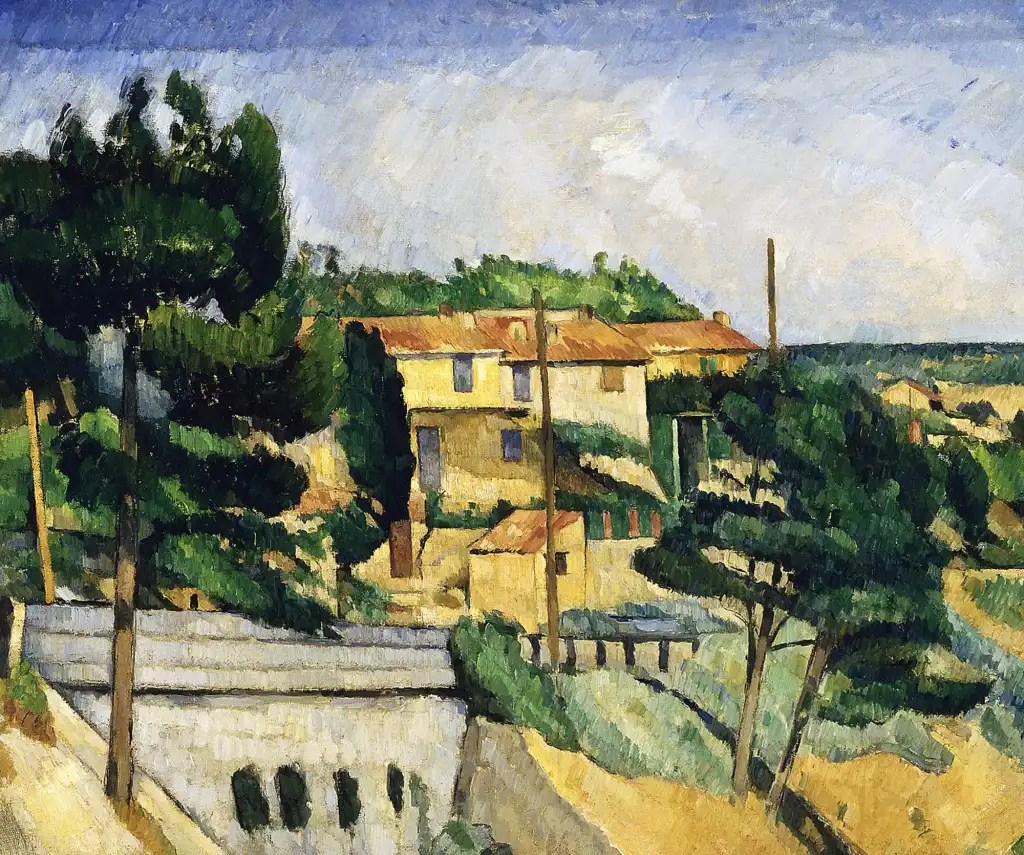In the rich tapestry of Paul Cézanne’s artistic oeuvre, “The Road Bridge at L’Estaque” holds a distinct place, stitched with the delicate threads of transition and anticipation of the modern art movement. Created between 1879 and 1882, this landscape painting is more than a visual record of the Provençal countryside; it is a reflection of Cézanne’s pivotal role in steering the art world towards new horizons. In this blog post, we will wade into the depths of Cézanne’s craft as displayed in this masterwork and discover why it is a cornerstone of his enduring legacy.
The Framework of Innovation
“The Road Bridge at L’Estaque” stands as a testament to Cézanne’s revolutionary perspective that sought to reconstruct nature through the lens of art. The bridge, a seemingly simple structure, is transformed into an object of profound significance under Cézanne’s brush. Its sturdy arches and the meandering road that crosses it are not merely depicted for their rural charm but are analyzed and rendered in a way that teases out the underlying geometry of the world.
A Pioneering Palette
Cézanne’s approach to color in “The Road Bridge at L’Estaque” resonates with an almost musical quality. He employs a palette that is at once muted and rich, creating a harmony that hums with the quiet vibrancy of life. His treatment of light and shadow is masterful; they are not direct imitations of reality but are instead used to sculpt form and space, giving the painting a robust, almost tactile presence.
Brushstrokes That Speak Volumes
The brushstrokes in this painting are deliberate, confident, and varied, demonstrating Cézanne’s dexterity and thoughtful approach to texture. Each stroke carries weight, contributing to a sense of volume and dimension that would inform the stylistic choices of future artists. The technique showcased in this work bridges the gap between the traditional and the innovative, hinting at the expressive possibilities that would be fully realized in later movements such as Cubism and Fauvism.
Capturing the Essence of Time and Place
“The Road Bridge at L’Estaque” is anchored in a specific moment and location, yet it transcends its own context. Cézanne captures the essence of the L’Estaque region, a place he visited repeatedly, with a fresh vision that distills the scene to its purest forms and colors. In this way, he reveals the timeless and universal nature of the landscape, allowing it to resonate with viewers across different eras.
The Artistic Journey Embodied
Cézanne’s painting is much like the bridge it depicts — a passage from one artistic realm to another. It is both a culmination of his intense study of nature and a bold step towards the abstraction that characterizes modern art. The bridge in L’Estaque is not just a physical structure within the painting; it is a metaphor for Cézanne’s role as an architect of a new visual language.
Conclusion: A Bridge to the Future
As part of our ongoing exploration of Paul Cézanne’s profound impact on art, “The Road Bridge at L’Estaque” is a quintessential work that showcases his transition from the Impressionist influence to the brink of modern abstraction. It is a visual exploration of the world, broken down into essential shapes and colors, that continues to influence and challenge the artistic landscape.
In embracing “The Road Bridge at L’Estaque,” we recognize not only the genius of Cézanne but also the enduring power of art to connect us to different times, places, and perspectives. It is a painting that does not just hang on a wall but stands as a landmark along the path of art history, inviting us to ponder the vistas that lie ahead.


Leave a Reply